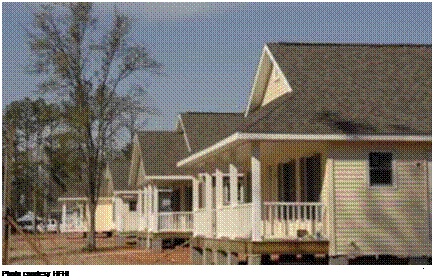STEP 4 PREPARE FOR THE WORST
Earthquakes, tornadoes, and hurricanes don’t come our way very often, but their brute force can be devastating—even fatal—if we’re not prepared. Look at what Katrina did to Louisiana and Mississippi. Disasters don’t just strike “other people.” Sometimes they happen to us.
I remember inspecting a house in California after the 6.8 Northridge earthquake. The house hadn’t collapsed, but the hot-water heater had been thrown 20 ft. out into the street. Other heavy appliances were scattered throughout the house. A good HVAC contractor knows which measures are required for securing equipment in areas where the risk of natural disasters is higher than normal. Steel strapping and other holddown hardware are available at most home centers. Check with your building department to see whether there are special requirements in your area for securing heaters and other appliances.
Smoke detectors and fire extinguishers save lives
Smoke detectors can and often do save lives, especially when a fire breaks out while you are sleeping. Most codes require that smoke detectors be installed in every bedroom and hallway. Some detectors are designed to be wired into your electrical system (with battery backup in case of power outages), whereas others work on battery power alone. You need to know the location of these units so you can check them every three to four months by pressing the test button that’s clearly visible on each detector.
If the unit is operating properly, it will emit a high-pitched sound.
A while back, a friend was visiting and left a small towel on top of the stove, not realizing that one of the burners was on. In just a minute or two, the towel was ablaze. A handy fire extinguisher quickly put an end to what could have been a major disaster. Fire extinguishers are inexpensive and have been put in all the Habitat houses I have worked on. Install one in the kitchen where it is easily visible and accessible so that anyone can locate it quickly. Drive the mounting screws into a stud so the fire extinguisher is securely attached.
![STEP 4 PREPARE FOR THE WORST Подпись: Rather than a lawn, try growing a garden in a few raised beds. Not only will you have veggies and flowers for your family, but there will be plenty to share with your neighbors. [Photo by Don Charles Blom]](/img/1312/image865.gif)
![STEP 4 PREPARE FOR THE WORST Подпись: Leave the lawn cutting to the parks and recreation department.Yards can be made attractive by using bark, chips, and a few native plants. [Photo by Don Charles Blom]](/img/1312/image866.gif)



![]() landscaping a yard to look like a city park? A well-tended yard can play a key role in making a house look and feel like a home, so what are
landscaping a yard to look like a city park? A well-tended yard can play a key role in making a house look and feel like a home, so what are
we to do?
For many homeowners the answer has been to think beyond a traditional lawn. Lawns are high maintenance. To avoid a visit from the homeowners association, you have to own, operate, and store a lawn mower. Watering a lawn is costly, and care of one often involves pesticides and chemical fertilizers, some of which can pollute our water systems and may affect our children’s health.
I have to admit that I’m not a big fan of lawns for the front or back yard. This may come from growing up in a place where my “lawn” was hundreds of miles of the open prairie. Lawn maintenance was the responsibility of grazing cows, horses, buffaloes, and prairie dogs.
There are many ways to make a yard attractive and welcoming. Something as simple as a curved sidewalk is a good place to start. Many people like to put down a liner that keeps weeds from growing and cover this with tree bark, mulch, or different kinds of rock. Native trees and shrubs can be planted to add greenery.
It makes sense to landscape with native plants. They flourish with little care and are truly a natural part of the landscape. Better to use plants that call the land around you home.
For me, the solution has been to remove the sod lawns on my property and replant native plants and an organic vegetable and flower garden. That way I can grow all kinds of delicious foods (see Resources on p. 279), and if I feel the need to walk on manicured grass, I can visit a golf course.
Also think about creating a special place in your yard where you can read or meditate. Try placing a bench under a tree where you can kick off your shoes, rest, and watch your children play. Even a few well-placed rocks can turn a common corner into an area of interest. Enjoy your new home!
[1] helped build my first house in 1948. It was a mail-order house brought to our small town by the Chicago and Northwestern Railroad, then to the site by horse and wagon. Every piece of the house frame was precut and tied in bundles. My job was to untie the bundles and bring the pieces to the carpenters who nailed them together.
Today, the same house pieces are needed, but most of them are cut to length on site. Headers are needed over door and window openings to transfer roof loads down to the subfloor and foundation. Rough sills support windows. Cripples or jack studs either support a rough sill or transfer weight from a top plate to a header. Trimmers extend on both sides of door and window openings to support headers (see the illustration on p. 87).
Before you can begin cutting or marking framing members, you need some basic information, including the standard stud length, the height at which headers will be set, the size and location of door and window openings, and
[2] Caulk the flange. Squeeze a generous bead of exterior caulk or sealant on the back of each window flange (see the photo above).
[3] started doing finish work as a helper to a cabinetmaker. In the 1950s, there were few factory – made cabinets available. Every cabinet that we installed in every house was built piece by piece on the job.
Today, there is no need to build cabinets on site. Home centers and cabinet shops carry many cabinet styles that are built to order. The price depends on a number of factors, including the amount of solid wood used in the construction; the style of doors and drawer fronts; and the quality of the hinges, handles, drawer slides, and other hardware. Most base cabinets are sized to provide a countertop height of 36 in. But other sizes and styles are available to accommodate wheelchair access and






Leave a reply